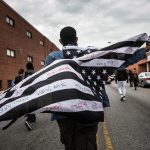Robert Frank’s negatives in black and white
The Switzerland-born photographer and author of The Americans leaves behind a legacy of images that define the photographic canon.
Author:
11 October 2019

The mysterious, unsettling and uncomfortably prescient collection of photographs published as The Americans in 1958, which document the zenith of the United States’ Golden Age, forms part of the legacy left by Swiss photographer and documentary filmmaker Robert Frank. He died at his home in Canada on 9 September 2019. He was 94.
Bleak scenes from across the US heartland reveal, as the introduction to a 2009 exhibition of the photographs and the source material he worked with and produced proclaims, “a country that many knew existed but few had acknowledged … a people plagued by racism, ill-served by their politicians, and rendered numb by a rapidly rising culture of consumption”.
It’s telling that this statement remains appropriate more than 50 years later and arguably applies to even more countries across a globalised yet increasingly nationalistic and xenophobic world.
Frank emigrated to the US in 1947 and after securing a Guggenheim Fellowship in 1955, spent two years crisscrossing the country – often with his wife and two children – on a series of road trips with the intention of documenting the US and all aspects of its society. Along the way, they encountered more than just the diners, drive-ins and jukeboxes captured in Frank’s pictures.
Frank, a European Jew, had been protected from Nazism by the borders of his native country of Switzerland. While making The Americans, he was stopped in a small town in Arkansas and put in jail. At the police station it was revealed that he was Jewish, and in one interview he recalls the sheriff telling him, “Well, we have to get somebody who speaks Yiddish.”
Mixed critical reception
The book was initially not well received. US magazine Popular Photography, famously derided his work as having “meaningless blur, grain, muddy exposures, drunken horizons, and general sloppiness”. Frank himself was described as a “joyless man who hates the country of his adoption”.
It seems that Frank was initially optimistic about his adopted country. But what he encountered on the road and, perhaps more importantly, what he captured on film, was decidedly negative.
Related article:
Nations, man-made creations that exist primarily as policies, reveal themselves in flags, currencies, maps, passports and most tangibly in borders. Abstract, unnatural, often straight lines that carve the world up into easily governable pieces. The tensions and conflicts that dominate contemporary headlines are often directly linked to these borders. Think of Palestine, Kashmir, Brexit, the Koreas and, of course, the racism and xenophobia tied to the anti-migrant sentiments that have unsettled Europe, America and South Africa.
In June this year, the photograph of the bodies of 24-month-old Angie Valeria and her father Oscar Alberto Martinez lying face down, dead in the waters of the Rio Grande, went around the world. The Rio Grande serves as a “natural border” between the US and Mexico.
Borders can be seen as a manifestation of a nation’s rules. Nothing respects borders except humans. Animal migrations, natural disasters, disease and, crucially, climate change, do not.
People who struggle
As the temperatures across the world rise, literally and metaphorically, the words of Frank during an interview with Time magazine resonate. “My mother always asked me. ‘Why do you always take pictures of poor people?’ … But my sympathies were with the people who struggled. There was also my mistrust of people who made the rules.”
While Frank was undoubtedly a master of making photographs, one of the standout features of The Americans is its deliberate and, at the time, groundbreaking editing.
The cover of the book carries simply its title and a single image of commuters on a trolley car in the city of New Orleans in Louisiana, US.
Related article:
At a time when the discriminatory Jim Crow laws still existed south of the Mason-Dixon line, long before the Civil Rights movement, it was a bold, perhaps even consciously political act to name a book The Americans and have black people sitting side by side with white families looking out the trolley windows toward an unseen America.
The last image of the publication is one of a woman and a child (presumably a mother and her child) in a tender moment, as they sit in a car pulled off on the side of a road in Texas. It’s a vignette of the weary family on the road to an undisclosed and perhaps uncertain destination.
But it is the opening image of the book where Frank’s thesis is most apparent. At a parade in Hoboken, New Jersey, two mysterious figures stand at windows, ostensibly watching the event on the street below. One is hidden by a blind pulled halfway down, the other by a flag billowing across the window, their vision obscured by the flag that defines and yet separates them from the world outside.


